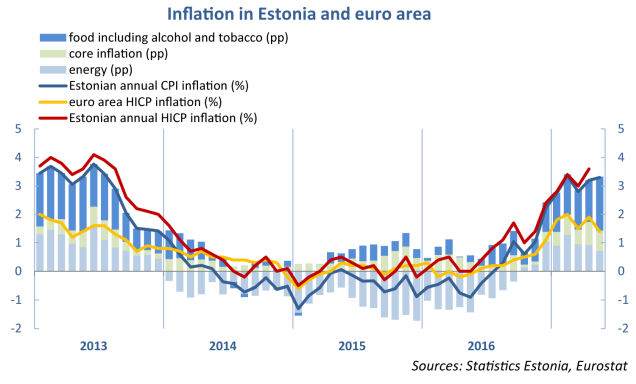Analytics, Banks, Direct Speech, Economics, Estonia, Inflation
International Internet Magazine. Baltic States news & analytics
Saturday, 20.04.2024, 01:17
Inflation in Estonia picked up a little in May
 Print version
Print version |
|---|
The rise in the consumer price index accelerated in the figures from Statistics Estonia to 3.3% in May 2017. Energy prices were up 5.3% over the year, and food prices, including alcohol and tobacco, were up 6.2%. Core inflation slowed to 1.2% though.
The structure of inflation has changed somewhat in recent months as energy prices are not rising as fast, but the broad-based inflation for food products continued in May. Estonia is something of an exception among euro area countries for the rapid rise in prices of food products. Inflation in May also saw some individual large changes in services prices, with prices for accommodation services standing 11% higher than they were a year earlier, possibly because of the Estonian Presidency of the European Union. Among residential services it was rent and waste disposal that drove inflation, but this was offset by cheaper communications services.
The immediate impact on consumer prices of the rise in the oil price that started in early 2016 has now eased. In January the global oil price was still 80% higher than it had been a year earlier, but by the end of May the difference over the year had dropped almost to zero. Prices of motor fuels were up 11% in May in Estonia, some 5 percentage points of which was due to the rise in excise on fuel in February. The indirect consequence of the higher oil price is transmitted into a second wave of inflation in prices for natural gas and heating energy. The prices of food and industrial commodities have fallen moderately on the global market in recent months. Commodities prices are being pushed down by uncertain demand in Asian countries.
The Estonian economy has improved noticeably since the second half of last year, and that has boosted the rise in consumer prices. Corporate profits increased in the first quarter by more than labour costs did for the first time since 2014, and they were helped in this by rapidly growing domestic demand and a revival in external demand. Corporate revenues rose because of increased export volumes and higher export prices, while on the cost side, the growth in wages slowed. The improved economic circumstances allowed companies to increase their profit margins and that will lead core inflation to rise in the second half of the year.
Inflation in Estonia is likely to remain high until the end of this year, because of both demand-side and supply-side (or cost-side) inflation factors. The coming months will see additional inflation caused by a rise in excise on alcohol. The key to long-term developments in prices is the price of oil on the global market, because oil has been relatively cheap for several years now. Eesti Pank will publish a new inflation forecast on 14 June 2017.









 «The Baltic Course» Is Sold and Stays in Business!
«The Baltic Course» Is Sold and Stays in Business!

